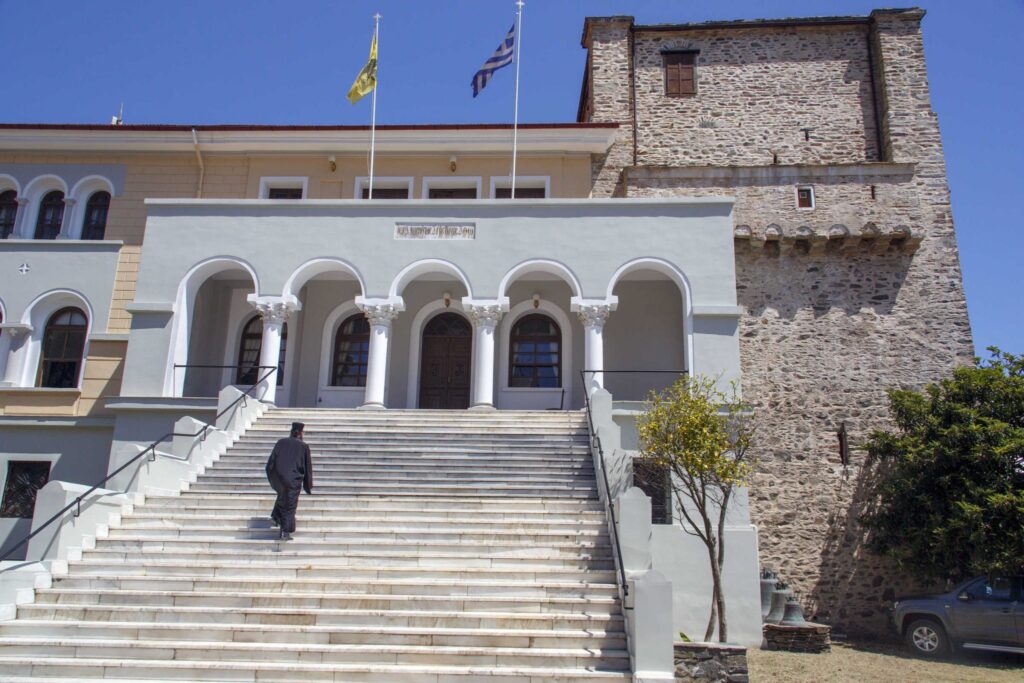The monastic settlements on Mount Athos can be separated into the following categories: the twenty monasteries and their dependencies – that is sketes, kellia, kalyves, hermitages and dwellings.
The above order reflects, to some extent, the number of the monks who live in the foundation and the austerity of the life there. On the other hand, in a settlement where many monks live together (such as a monastery or a skete), nobody can possess his own property. Everything is held in common. Monks from various countries live on Mt. Athos. However, everyone who comes to Mt. Athos and takes the monastic habit becomes a Greek citizen.
According to the Constitutional Charter of the Holy Mountain, which is enshrined in the constitution of Greece, Mt. Athos is a self-governing part of the Greek state and is subject spiritually to the Ecumenical Patriarchate of Constantinople. The Holy Community (‘Ιερὰ Κοινότης) is the governing body of the Mountain and it is based at Karyes. It is the board of the twenty representatives of the monasteries, who are chosen, one from each monastery, for a one-year term.
The Chairman of the Holy Community is the ‘Protos’ (first, or primate) who is chosen by rotation for one year from the first five monasteries. Although the Protos is the chairman of the Holy Community, his vote is only advisory. The Protos is the first in rank and the chairman of the Holy Supervisory Committee for the year in which he is elected.
Executive authority rests with the Holy Supervisory Committee of the Community (‘Ιερὰ Ἐπιστασία). Each of the five groups of this body represents four monasteries. Those four members constitute the Holy Supervisory Committee for one year from June 1st to the end of May and after this the next group takes over. The division of the monasteries into five groups of four monasteries each is shown below:
Group A
The Holy Monastery of the Great Lavra (1)
The Holy Monastery of the Dochiariou (10)
The Holy Monastery of Xenofontos (16)
The Holy Monastery of Esphigmenou (18)
Group B
The Holy Monastery of Vatopediou (2)
The Holy Monastery of Koutloumousiou (6)
The Holy Monastery of Karakalou (11)
The Holy Monastery of Stavronikita (15)
Group C
The Holy Monastery of Iviron (3)
The Holy Monastery of Pantokrator (7)
The Holy Monastery of Philotheou (12)
The Holy Monastery of Simonopetra (13)
Group D
The Holy Monastery of Hilandar (4)
The Holy Monastery of Xeropotamou (8)
The Holy Monastery of Agiou Pavlou (St Paul) (14)
The Holy Monastery of Grigoriou (17)
Group E
The Holy Monastery of Dionysiou (5)
The Holy Monastery of Zographou (9)
The Holy Monastery of Saint Panteleimon (Rossikon) (19)
The Holy Monastery of Konstamonitou (20)
The numbers in brackets denote the Athonite order of precedence.
There is also a Double Assembly (Διπλὴ Σύναχις) which is called by default twice per year. It is made up of the Abbots together with the representatives of each monastery in the Holy Community. It can be also called for extraordinary sessions and deals with the most important issues concerning Mount Athos.
The Greek state supervises Mt. Athos and has the executive right to maintain public order and security. State power and authority is exercised by the Civil Administrator who has the rank of Prefect and is subject to the Ministry of the Interior. The Civil Administrator may take part in the meetings of the Holy Community only by invitation and his vote is simply consultative.
